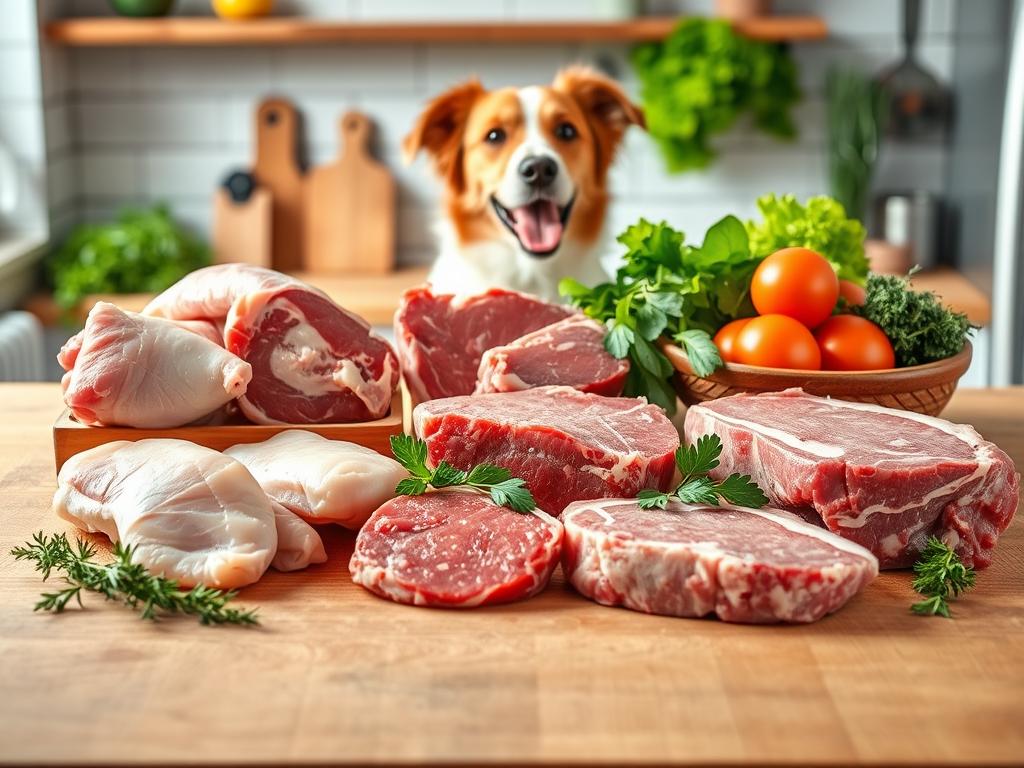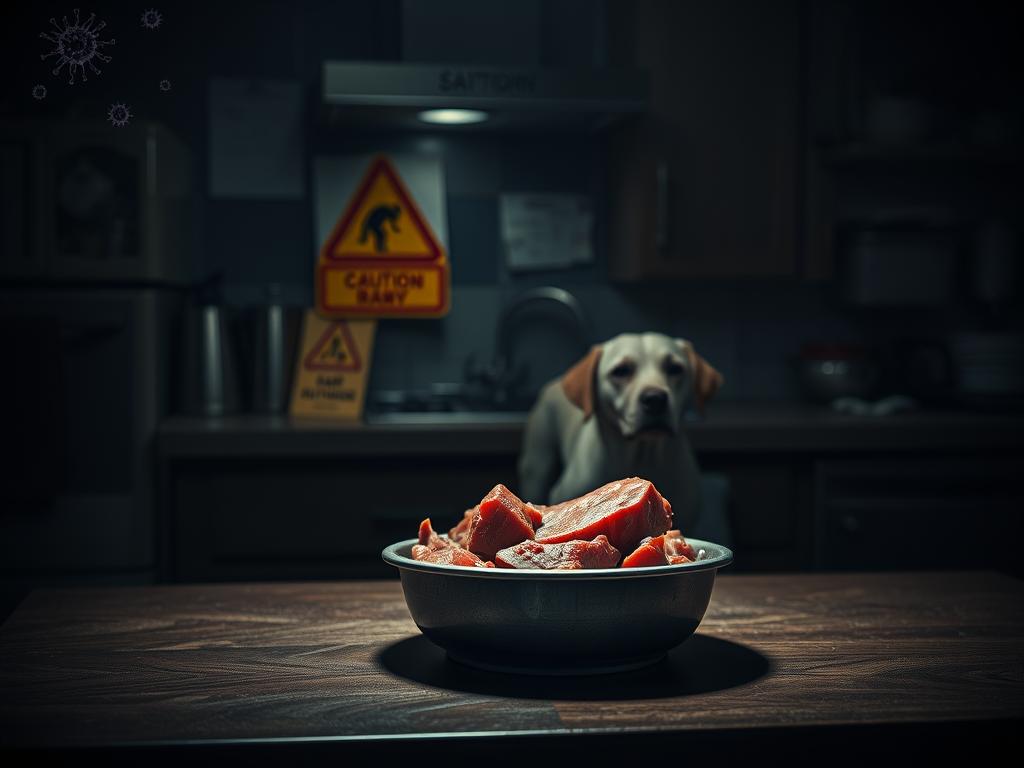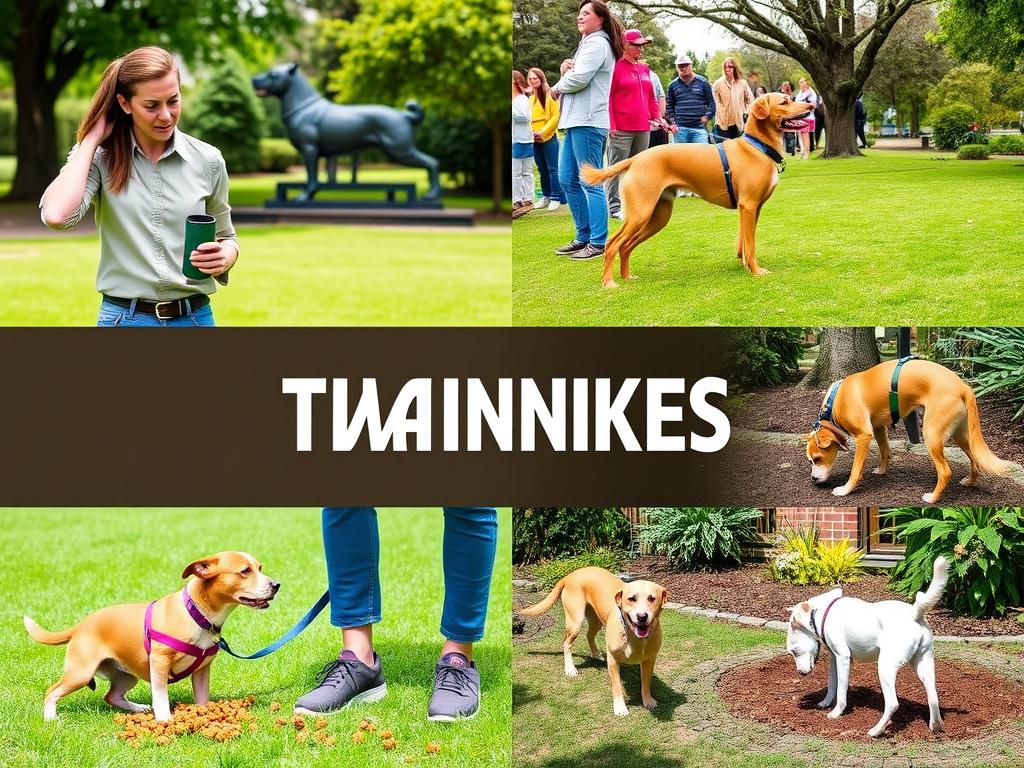Meat for Dogs :Did you know that interest in raw diets for dogs has soared since the early 90s, particularly among owners who wish to replicate the diets of working dogs like racing greyhounds and sled dogs? As these diets, including the BARF (Bones and Raw Food) regimen, have gained popularity, a heated debate has emerged regarding their benefits and risks for canine nutrition. Advocates argue that raw feeding for dogs mirrors the natural eating habits of their wild ancestors, potentially leading to healthier skin, improved energy levels, and better digestion.
However, many veterinary organizations caution against the practice, citing concerns about bacterial contamination, nutritional imbalances, and other health risks. Understanding the intricate balance between the benefits and risks of feeding dogs raw meat is essential for making informed decisions about your pet’s diet.
Key Takeaways
- Interest in raw diets for dogs has risen since the early 90s, but the benefits remain debated.
- Veterinary authorities often caution against raw feeding due to health risks.
- Balanced, complete diets formulated by pet nutritionists are recommended for overall canine health.
- Transitioning to raw diets should be done gradually over 7-10 days.
- Bacterial contamination poses significant health risks when feeding raw diets.
Understanding Raw Meat Diets for Dogs
Raw meat diets for dogs have gained popularity among dog owners seeking to provide their pets with a more natural and wholesome approach to nutrition. Understanding raw meat diets involves exploring the components and brands associated with this feeding method.
What is a Raw Meat Diet?
A raw diet for dogs typically comprises uncooked meats, bones, fruits, and vegetables, adhering to the belief that a dog’s ancestors thrived on similar diets. This approach emphasizes whole, natural ingredients that mirror the diet dogs might have consumed in the wild.
Ingredients Typically Used
Essential components of a raw meat diet include:
- High-quality muscle meats
- Meaty bones, either whole or ground
- Organ meats like liver and heart
- Raw eggs for protein and fatty acids
- Fruits such as apples
- Vegetables like spinach or broccoli
- Dairy products like yogurt for calcium
This combination is crucial for maintaining overall canine nutrition and ensuring dogs receive the necessary vitamins and minerals.
Popular Raw Meat Diet Brands
Several popular raw meat diet brands cater to the growing demand for raw dog food, and they vary in ingredient quality and nutrient balance.
| Brand | Type | Key Features |
|---|---|---|
| Nature’s Variety | Frozen Raw | High-quality ingredients sourced and frozen for freshness |
| Stella & Chewy’s | Freeze-Dried Raw | Human-grade ingredients with a focus on balanced nutrition |
| Primal Pet Foods | Raw and Freeze-Dried | All-natural ingredients with no fillers or artificial additives |
These brands emphasize their commitment to using premium ingredients designed to support a dog’s health and well-being through raw feeding for dogs.

Benefits of Feeding Dogs Raw Meat
Transitioning to a raw diet for dogs is associated with numerous raw food benefits. Many dog owners report remarkable improvements in their pets’ overall health, particularly when it comes to coat and skin condition. By focusing on fresh ingredients, dogs often display enhanced vitality.
Improved Coat and Skin Health
One of the most noticeable changes observed with a raw diet is improved coat health. Dogs often achieve shinier fur and healthier skin due to the higher fat content found in raw meat. Essential fatty acids, particularly omega-3 and omega-6, contribute significantly to revitalizing a dog’s coat. Ingredients like salmon and flax seeds offer these beneficial fats, promoting healthier skin and reducing incidences of skin allergies.
Increased Energy Levels
Another compelling reason to consider a raw diet for dogs lies in the noticeable boost in energy levels. Many pet owners have reported that their dogs become more lively and playful after switching to raw feeding. This increased energy can be attributed to the rich protein and fat content in raw meats, coupled with the absence of fillers commonly found in commercial kibble. With easier digestion and better absorption of nutrients, dogs can enjoy enhanced vitality.
Better Digestion
Health benefits of raw feeding often extend to improved digestion. With minimal processing, raw ingredients closely mimic a dog’s natural diet, making it easier for their bodies to digest. As a result, many owners notice reduced stool volume and odor, in addition to benefiting overall digestive health. Incorporating raw, meaty bones contributes not only to dental health but also introduces beneficial fiber from certain vegetables.
Making informed choices about your dog’s nutrition can lead to significant long-term health advantages. For more insights on this subject, check out the health benefits of raw feeding.
Potential Risks of Raw Meat Diets
While raw meat diets for dogs have gained popularity, they are not without their challenges. Understanding the potential risks is essential for making informed decisions regarding your pet’s nutrition.
Bacterial Contamination
One of the most significant raw dog food risks involves bacterial contamination. Raw meat can carry harmful bacteria such as Salmonella and E. coli. These pathogens pose health risks not only to dogs but also to their owners. Studies have indicated that these bacteria can be present in a considerable percentage of raw meat-based diets. Therefore, following safety guidelines for handling raw meat is crucial to minimize these risks.
Nutritional Imbalance
Creating a nutritionally balanced raw diet can be complicated. A common concern is a nutritional imbalance, which may result from improper formulation. Research has shown that many homemade raw diets fail to provide essential vitamins and minerals, leading to long-term health issues for dogs. Veterinary nutritionists emphasize that unsupervised raw feeding can lead to deficiencies or excesses that may harm your dog’s health.
Bone Hazards
Another noteworthy aspect of raw diets is the inclusion of bones, which can present various hazards. While bones are a core component, they can splinter and cause choking, tooth fractures, or even internal punctures. The risks of bone hazards demand careful selection and supervision during feeding. Cooked bones are particularly dangerous, as they are more prone to splintering than raw bones.

Important Considerations Before Switching
Making a switch to a raw food diet for your dog requires careful thought and planning. Before embracing this dietary change, critical steps must be taken to ensure that it aligns with your pet’s specific needs. Understanding how to approach this transition will lead to better health outcomes for your furry friend.
Consulting with a Veterinarian
Consulting with a veterinarian is fundamental when considering a raw diet for your dog. A vet can assist in evaluating the health of your dog and guide you in determining if a raw food diet is appropriate, especially through raw diet evaluation. This professional insight is particularly important for dogs with pre-existing conditions. Their expertise can prevent potential complications and ensure your dog receives the necessary nutrition.
Assessing Your Dog’s Health
Assessing your dog’s health plays a crucial role in this process. Factors such as age, breed, and existing health issues may influence dietary suitability. Conditions like kidney disease or allergies require enhanced attention, making it essential to monitor health metrics closely. Performing a thorough health assessment can help you make informed decisions during the transition.
Transitioning to Raw Gradually
Transitioning to raw gradually is key to minimizing gastrointestinal upset. Starting with small portions of raw food mixed with regular food over a period of 7 to 10 days allows the dog’s digestive system to adapt. A slow raw food diet adjustment can prevent common issues like diarrhea or vomiting, ensuring a smoother transition. This gradual approach helps your dog become accustomed to the new diet while maintaining their overall health.

Safe Practices for Feeding Raw Meat
Transitioning to a raw meat diet for dogs requires safe feeding practices that protect both the animals and their human families. Adopting proper storage techniques, maintaining hygiene and cleanliness, and closely monitoring dog’s reactions are essential steps to ensure a successful experience.
Proper Storage Techniques
Correct storage of raw meat is crucial to minimize bacterial growth and contamination. Always store raw meat in airtight containers within the refrigerator or freezer to keep it safe. It is recommended to thaw meat in the refrigerator or with cold water, ensuring it never sits uncovered at room temperature. This approach helps maintain the integrity of the meat while significantly reducing risks associated with improper storage. Following the best practices for raw diet observations can also help you mitigate contamination risks.
Hygiene and Cleanliness
Practicing good hygiene in raw feeding protects both pets and their humans. Pet owners should wash their hands thoroughly before and after handling raw meat and be diligent about cleaning all surfaces, utensils, and equipment exposed to raw food. Such hygiene and cleanliness measures help prevent bacterial contamination and reduce health risks. Make it a habit to sanitize work areas and dispose of raw food waste properly to ensure a safe feeding environment.
Monitoring Your Dog’s Reactions
After switching to a raw diet, closely monitoring your dog’s reactions is vital. Keep an eye out for any signs of discomfort, changes in stool quality, or vomiting, as these could indicate dietary issues. Regular vet check-ups will help assess your pet’s health during this transition, ensuring that they are adjusting well to their new diet. Observing your dog after meals enables a better understanding of how they respond to their raw food, ensuring adjustments can be made if necessary.
| Practice | Description |
|---|---|
| Storage | Keep raw meat in airtight containers and store in the refrigerator or freezer. |
| Thawing | Thaw safely in a refrigerator or cold water; never at room temperature. |
| Hand Hygiene | Wash hands thoroughly before and after handling raw meat. |
| Surface Cleaning | Sanitize all surfaces and utensils used for raw meat. |
| Observation | Monitor dog’s reactions and report any concerning changes to a veterinarian. |
Final Thoughts on Raw Meat for Dogs
As you consider the prospect of feeding your furry friend a raw meat diet, it’s essential to engage in a thorough raw dog food evaluation. This style of feeding presents a variety of benefits such as enhanced coat health and increased energy. Nevertheless, the potential risks associated with bacterial contamination and nutritional imbalances must not be neglected. To truly make an informed decision, pet owners should focus on weighing the pros and cons associated with both raw and traditional diets.
Weighing the Pros and Cons
Every dog is unique, and personalizing your dog’s diet is crucial. Factors like age, weight, health conditions, and activity level play significant roles in determining the appropriate diet for your pet. Customizing their nutrition ensures they receive essential vitamins and minerals while addressing any digestive concerns. Being aware of your dog’s specific needs fosters a sense of dog nutrition awareness that cannot be overlooked.
Making an Informed Decision
Ultimately, transitioning to a raw diet should be handled with care and thoughtfulness. Engaging your veterinarian in discussions will help guide you towards a safe and nutritious regimen tailored for your dog. Additionally, considering pre-packaged options that follow high hygiene standards can streamline your choices. Taking these steps not only enhances your dog’s well-being but also minimizes potential health risks. For more guidance on addressing sensitive stomach issues with tailored nutrition, check out this informative source on dog food for sensitive stomachs.











